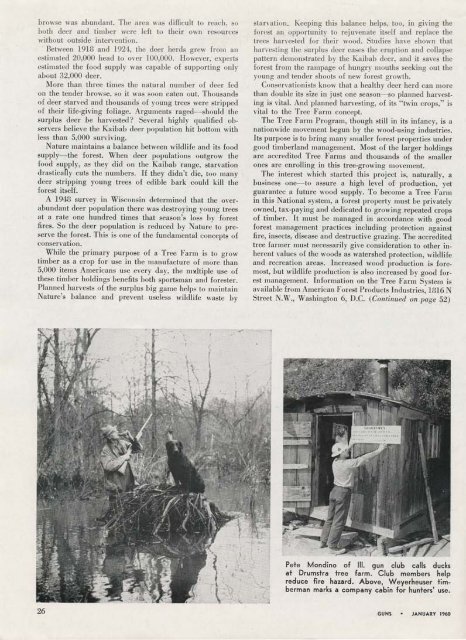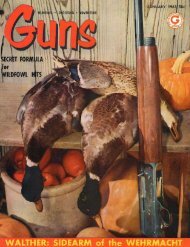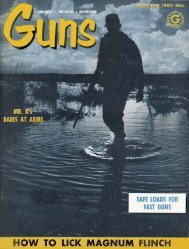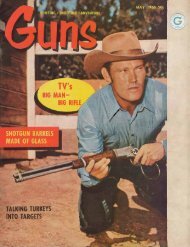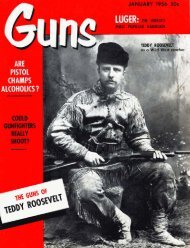You also want an ePaper? Increase the reach of your titles
YUMPU automatically turns print PDFs into web optimized ePapers that Google loves.
owse was abundant. The area was difficult to reach, so<br />
both deer and timber were left to their own resources<br />
without outside intervention.<br />
Between 1918 and 1924, the deer herds grew from an<br />
estimated 20,000 head to over 100,000. However, experts<br />
estimated the food supply was capable of supporting only<br />
about 32,000 deer.<br />
More than three times the natural number of deer fed<br />
on the tender browse, so it was soon eaten out. Thousands<br />
of deer starved and thousands of young trees were stripped<br />
of their life-giving foliage. Arguments raged-should the<br />
surplus deer be harvested? Several highly qualified observers<br />
believe the Kaibab deer population hit bottom with<br />
less than 5,000 surviving.<br />
Nature maintains a balance between wildlife and its food<br />
supply-the forest. When deer populations outgrow the<br />
food supply, as they did on the Kaibab range, starvation<br />
drasticany cuts the numbers. If they didn't die, too many<br />
deer stripping young trees of edible bark could kill the<br />
forest itself.<br />
A 1948 survey in Wisconsin determined that the overabundant<br />
deer population there was destroying young trees<br />
at a rate one hundred times that season's loss by forest<br />
fires. So the deer population is reduced by Nature to preserve<br />
the forest. This is one of the fundamental concepts of<br />
conservation.<br />
While the primary purpose of a Tree Farm is to grow<br />
timber as a crop for use in the manufacture of more than<br />
5,000 items Americans use every day, the n1Y.ltiple use of<br />
these timber holdings benefits both sportsman and forester.<br />
Planned harvests of the surplus big game helps to maintain<br />
Nature's balance and prevent useless wildlife waste by<br />
starvation. Keeping this balance helps, too, in giving the<br />
forest an opportunity to rejuvenate itself and replace the<br />
trees harvested for their wood. Studies have shown that<br />
harvesting the surplus deer eases the eruption and collapse<br />
pattern demonstrated by the Kaibab deer, and it saves the<br />
forest from the rampage of hungry mouths seeking out the<br />
young and tender shoots of new forest growth.<br />
Conservationists know that a healthy deer herd can more<br />
than double its size in just one season-so planned harvesting<br />
is vital. And planned harvesting, of its "twin crops," is<br />
vital to the Tree Farm concept.<br />
The Tree Farm Program, though still in its infancy, is a<br />
nationwide movement begun by the wood-using industries.<br />
Its purpose is to bring many smaller forest properties under<br />
good timberland management. Most of the larger holdings<br />
are accredited Tree Farms and thousands of the smaller<br />
ones are enrolling in this tree-growing movement.<br />
The interest which started this project is, naturally, a<br />
business one-to assure a high level of production, yet<br />
guarantee a future wood supply. To become a Tree Farm<br />
in this National system, a forest property must be privately<br />
owned, tax-paying and dedicated to growing repeated crops<br />
of timber. It must be managed in accordance with good<br />
forest management practices including protection against<br />
fire, insects, disease and destructive grazing. The accredited<br />
tree farmer must necessarily give consideration to other inherent<br />
values of the woods as watershed protection, wildlife<br />
and recreation areas. Increased wood production is foremost,<br />
but wildlife production is also increased by good forest<br />
management. Information on the Tree Farm System is<br />
available from American Forest Products Industries, 1816 N<br />
Street N.W., Washington 6, D.C. (Continued on page 52)<br />
Pete Mondino of III. gun club calls ducks<br />
at Drumstra tree farm. Club members help<br />
reduce fire hazard. Above, Weyerheuser timberman<br />
marks a company cabin for hunters' use.<br />
26 <strong>GUNS</strong> JANUARY <strong>1960</strong>


